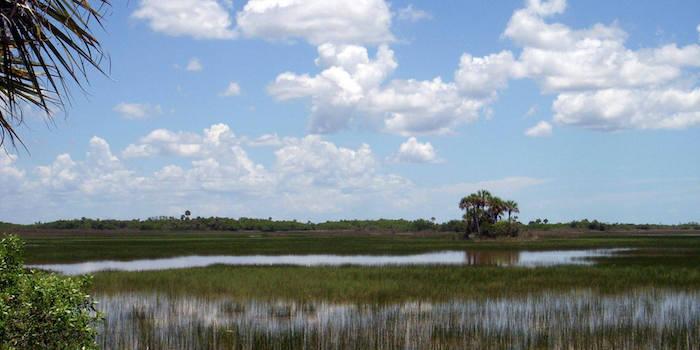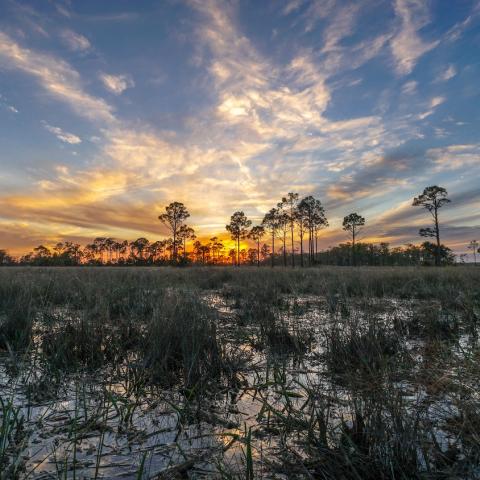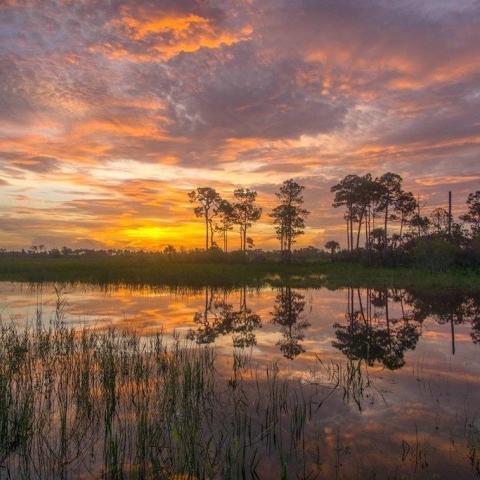
A coalition of environmental organizations Wednesday filed a lawsuit to stop oil exploration in Big Cypress National Preserve in Florida/NPS
A National Park Service decision to allow for oil exploration in Big Cypress National Preserve on Wednesday drew a lawsuit from a coalition of environmental groups that fear the seismic work could adversely impact wildlife including the endangered Florida panther and pose a threat to "drinking water for many South Floridians."
“Oil and gas companies have no place in our national parks and preserves,” said Alison Kelly, staff attorney with the Natural Resources Defense Council, said in a release. “Oil exploration and development in Big Cypress could push the rare Florida panther toward the brink of extinction, threaten wetlands and safe drinking water for thousands of people, and damage a popular destination for outdoor lovers. The federal government should protect Big Cypress for the American people and not allow a dirty energy company to transform it into an industrial zone.”
The Natural Resources Defense Council, Center for Biological Diversity, National Parks Conservation Association, Conservancy of Southwest Florida, Earthworks, and South Florida Wildlands Association brought the lawsuit (attached below) against the Park Service, alleging that it violated the National Environmental Policy Act earlier this year "when it approved the Texas-based Burnett Oil Company’s proposal to explore for oil and gas in more than 110 square miles (70,000 acres) of the preserve—an area five times the size of Manhattan—without adequately considering the environmental impacts. While the surface of this land is owned by the federal government, much of the minerals underground are privately owned."
Instead of conducting an Environmental Impact Statement, an exhaustive document that would closely examine how wildlife and vegetation might be impacted by the surveying work, Big Cypress staff wrote a less stringent Environmental Assessment looking at the exploration. The seismic testing will use vibroseis vehicles, massive trucks that weigh up to 22 tons. They create ground-penetrating seismic waves by exerting all their weight onto a vibrating steel pad. The shock waves are received by small instruments called "geophones," allowing the geologists to create a three-dimensional map of the underlying ground.
If the Burnett Oil survey proceeds as intended, it would be "the only vibroseis survey identified exclusively for off-road ever attempted in the state," according to the Park Service.
Bob DeGross, the preserve's chief of interpretation and public affairs, told the Traveler earlier this summer that necessary safeguards have been stipulated by staff to ensure no lasting impacts result from the surveying, which isn't expected to begin at least until the dry season arrives in the fall. Those safeguards call for observers -- including archaeologists and biologists -- to scout proposed routes for sensitive species and guide the vibroseis vehicles through the boggy landscape. Crews with shovels and rakes are to be on hand to restore "original contour conditions" if necessary. As a result, he said, there was no need for the more exhaustive EIS.
In a statement provided the Traveler in June, officials for Collier Resources Co. said they are entitled through the legislation that created Big Cypress to explore for energy reserves and develop them if they see value in it.
“There have been a number of oil and gas exploration operations in the Big Cypress National Preserve and proprietary geological studies, combined with new technology and a better understanding of the reserves available, indicate that there may be the potential to recover billions of dollars worth of oil on privately held minerals. To unlock this potential, while mitigating impacts to the environment, Collier Resources Company’s lessees must go through a rigorous state and federal permitting process to obtain permits to conduct 3-D seismic surveying operations. Seismic surveying is not new to the area and gives CRC’s lessees the ability to determine more precisely where potential new oil fields are located. There will also be a state-approved biologist and archaeologist on site at all time to instruct crew to avoid disturbing wildlife and cultural sites. And, finally, hundreds of miles of 2-D lines have been surveyed throughout the Big Cypress National Preserve and present day satellite imagery shows no detectable impacts to the preserve."
Despite the 46-item list of management strategies the Park Service came up with to protect the backcountry of Big Cypress, there remain concerns among some groups that the agency should have conducted an EIS.
“The impacts to wetlands, wildlife and cypress trees caused by these colossal trucks pounding the ground are unacceptable,” Jaclyn Lopez, Florida director at the Center for Biological Diversity, said Wednesday. “And if they eventually end up drilling for oil or gas, this last remaining intact habitat for rare and threatened wildlife will be put at tremendous risk.”

Among the concerns voiced by the groups is that exploration could adversely impact the endangered Florida panther that resides in the preserve and neighboring Everglades National Park/NPS
The groups filed their lawsuit in the U.S. District Court for the Middle District of Florida. Last week, the groups also sent a notice of intent to sue the National Park Service and the U.S. Fish & Wildlife Service over the impacts the oil and gas exploration would have on endangered and threatened animal species in the preserve.
Big Cypress and Everglades National Park combined protect a sprawling, humid expanse of subtropical landscape of more than 2.2 million acres. Within this moist, marshy acreage is an amazing, and unusual, assemblage of flora and fauna.
There are rare woodpeckers that live in family groups, with youngsters helping to raise their siblings. There's a subspecies of panther (listed as an endangered species nearly five decades ago) that has tenaciously survived despite the steady urbanization of Florida. More than 30 species of orchids grow in Big Cypress, perhaps most notable among them the Ghost orchid that snakes its roots around the trunk of its host tree, anchoring its beautiful flowers. And there is the Everglades Dwarf Siren, a curious salamander with bushy gills that can grow up to 10 inches long.
And underlying their collective habitats, beneath the Big Cypress Swamp that the national preserve was established in 1974 to protect and preserve for the rest of time, lies fractured rock, a porous honeycomb of limestone and, perhaps, oil.

Exploration for oil would be conducted by vibroseis trucks weighing up to 66,000 pounds/NPS
“The Big Cypress National Preserve is one of the most biodiverse pieces of public land in North America,” said Matthew Schwartz, executive director of the South Florida Wildlands Association. “Not only is the preserve ground zero for the highly endangered Florida panther, but it provides habitat for hundreds of other native plants and animals – many federally or state protected – in a rapidly growing part of Florida. It is unconscionable for the National Park Service to have approved 70,000 acres of seismic testing without a full Environmental Impact Statement. We are hoping that this legal action will lead directly to that required review – and to a new approach from the service which puts resource protection first.”
According to the groups, the extreme noise and disturbance from seismic survey activities in the area "could be catastrophic for the panther and other native wildlife—threatening increased displacement, mortality, reproductive failure, and stress levels. A healthy Big Cypress ecosystem is essential to the health of nearby coastal estuaries, which are home to endangered manatees, sea turtles and countless fish."
Big Cypress provides nearly half of the water that flows into Everglades, and recharges important underground drinking water sources. This includes portions of the Biscayne Aquifer, which provides most of the fresh water for homes and agriculture in southeast Florida.
“The Big Cypress National Preserve is an environmentally sensitive and important part of the Western Everglades,” said Jennifer Hecker, director of natural resource policy for the Conservancy of Southwest Florida. “Expanding oil and gas activities in this area, especially in light of the onset of fracking in Florida, poses enormous risks to water resources and threatens to undermine the substantial public investment being made to protect and restore a national treasure – the Everglades – which depends on sufficient amounts of clean freshwater."
Additionally, the preserve is an economic generator for the state and a popular destination for outdoor recreation, from hiking, to bird-watching, kayaking, and camping. Nearly 1.2 million people visited Big Cypress last year and spent nearly $90 million in and around the surrounding communities.
The seismic activity approved in May is only the beginning, the groups contend.
"Burnett’s broader plan includes three additional phases of exploration. The first, approved phase alone rivals the largest seismic testing operations ever to occur in a national park unit. If all four phases are approved, the area affected would ultimately encompass about one-third of the preserve (366 square miles or 234,000 acres), an area larger than many national parks, including Shenandoah, Acadia, Crater Lake, Biscayne, and Zion," they said in the release. "On top of that, seismic exploration could be just the first step in destructive oil development in the area. If Burnett finds oil or gas in the preserve, it will likely lead to harmful oil or gas development such as drilling, fracking, or acidizing—and the roads, pipelines and more that go with it, bringing even greater disturbance and risks to wildlife, habitat, and water supplies."
At the National Parks Conservation Association, Nick Lund, senior manager for conservation programs, said "(T)he National Park Service has failed to uphold its fundamental duties to protect one of America’s prized national park units and its endangered wildlife. Instead, they’ve greenlighted a project that would have massive physical impacts to the preserve with minimal environmental review. Once exploration of this magnitude begins, the landscape and native wildlife will forever be changed.”
“The Park Service must keep our lands and resources in trust for us and future generations,” added Aaron Mintzes, policy advocate at Earthworks. “Allowing oil and gas development is fundamentally incompatible for a place we call a preserve.”




 Support Essential Coverage of Essential Places
Support Essential Coverage of Essential Places







Add comment